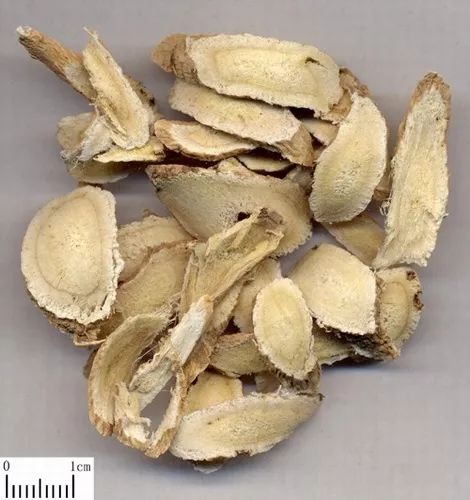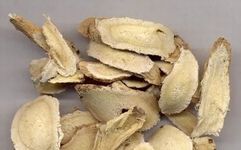Astragalus (Huang Qi)
(Mian Qi; Mian Huang Qi; Huang Qi; Du Zhen; Shu Zhi; Bai Ben; Bai Yao Mian; Huang Shen; Xue Shen; Ren Xian)

Astragalus is the dried root of the leguminous plant Mongolian Astragalus (Huang Qi) or Membranous Astragalus. It can be cultivated or found in the wild. Mongolian Astragalus is mainly produced in Inner Mongolia, Jilin, Shanxi, and Hebei; Membranous Astragalus is mainly produced in Shanxi, Heilongjiang, Gansu, and Inner Mongolia. The original plant grows on slopes, beside ditches, or in thickets, preferring dry, sunny conditions, and thrives best in deep, humus-rich, well-drained, medium to slightly alkaline sandy loam. It has a sweet taste and a warm nature. It belongs to the Lung and Spleen meridians. Its functions include tonifying Qi, stabilizing the exterior, promoting diuresis, expelling toxins, draining pus, and promoting wound healing. Clinical names include Astragalus and honey-fried Astragalus.
【Bencao Huiyan】
According to the Shennong Bencao Jing: Astragalus has a sweet and slightly warm taste. It is indicated for abscesses, chronic non-healing wounds, draining pus, alleviating pain, wind disorders, dysentery, hemorrhoids, and various pediatric diseases. It is also known as Dai Shan. It grows in valleys.
The Famous Doctors states: It is also called Dai Zhen, Du Zhen, Ji Cao, Shu Zhi, Bai Ben, and it grows in Shu County, Baishui, and Hanzhong, harvested in February and October, and dried in the shade.
The Famous Doctors’ Supplement: It is non-toxic. It is used to treat women with wind-evil in the uterus, expel bad blood from the five organs, tonify male deficiencies, alleviate fatigue and weakness, stop thirst, relieve abdominal pain and diarrhea, benefit Qi, and promote Yin Qi.
The Yao Xing Lun: It treats back pain, internal tonification, and is indicated for deficiency cough, kidney failure, and deafness, and treats cold and heat.
The Rihua Zi Bencao: It is harmful to white fresh skin. It assists Qi, strengthens muscles and bones, promotes flesh growth, nourishes blood, breaks phlegm, treats scrofula, and addresses intestinal wind, blood collapse, and dysentery, as well as all diseases before and after childbirth, irregular menstruation, thirst, cough, and treats head wind heat toxin and red eyes.
The Kaibao Bencao: It has a sweet taste, is slightly warm, and is non-toxic. It is used for women with wind-evil in the uterus, expelling bad blood from the five organs, tonifying male deficiencies, alleviating fatigue and weakness, stopping thirst, relieving abdominal pain and diarrhea, benefiting Qi, and promoting Yin Qi.
The Bencao Yanyi: Fang Feng and Astragalus are often used together. During the Tang Dynasty, Xu Yinzong was a military officer for the King of Xincai. The Empress Dowager Liu was ill with wind and could not speak, her pulse was deep and difficult to detect, and the doctor said the treatment was exhausted. Yinzong said: “The decoction cannot be taken.” He then boiled a large quantity of Astragalus and Fang Feng, placed it under the bed, and the vapor like mist wafted up, and that evening she was able to speak.
The Yao Lei Fa Xiang: It treats deficiency, spontaneous sweating, tonifies lung Qi, strengthens the skin, and drains fire from the lungs. If the pulse is wiry and there is spontaneous sweating, it is effective for weak spleen and stomach, ulcers, and blood vessels not flowing, and is essential for internal Yin deficiency and ulcers.
The Tang Ye Bencao: Astragalus
Content: Qi is warm, taste is sweet, pure Yang. Sweet, slightly warm, neutral. Non-toxic. It enters the Hand Shaoyang, Foot Taiyin, Foot Shaoyin, and Mingmen channels.
The Xiang states: It treats deficiency, spontaneous sweating, tonifies lung Qi, enters the skin, drains fire from the lungs. If the pulse is wiry and there is spontaneous sweating, it is effective for weak spleen and stomach, ulcers, and blood vessels not flowing, and is essential for internal Yin deficiency and ulcers. Remove the reed.
The Zhen states: It benefits stomach Qi, removes muscle heat, and is essential for all pains.
The Xin states: It tonifies the five organs’ deficiencies, drains Yin fire, and removes deficiency heat. If there is no sweating, it will induce it; if there is sweating, it will stop it.
The Bencao states: It is indicated for abscesses, chronic non-healing wounds, draining pus, alleviating pain, wind disorders, dysentery, hemorrhoids, and various pediatric diseases. It benefits Qi and promotes Yin Qi.
There are Bai Shui, Chi Shui, and Mu, all with the same functions. Only Mu has a short stem and horizontal growth, breaking like cotton, with yellow-brown skin and white flesh, known as Mian Huang. The hard and bitter ones are Alfalfa roots. It is also said to break phlegm, intestinal wind, blood collapse, and dysentery, as well as all diseases before and after childbirth, irregular menstruation, thirst, cough, and treats head wind heat toxin and red eyes. It grows in Shu County, Baishui, and Hanzhong, and is now widely cultivated in He Dong, Shaanxi Province. It has the same functions as cinnamon, but its taste is slightly different, being sweeter and milder, not spicy or hot. People often use Alfalfa roots as a substitute, calling it Tu Huang, but it is bitter and can cause weight loss, while the sweet ones can cause weight gain. It can easily be confused, so users should be careful. It treats Qi deficiency, spontaneous sweating, and is a surface medicine; it also treats skin pain, so it is known as a surface medicine; it also treats coughing blood, softens the spleen and stomach, which is a central medicine; it also treats cold damage, and if the pulse is weak, it can tonify kidney essence, which is an internal medicine. It is a medicine for the upper, middle, lower, internal, and external three jiaos.
Now, the Bencao and Tujing only mention He Dong, which refers to the cotton produced there, hence it is called Mian. Its taste is sweet like honey, and its body is soft like cotton, which is why it is called Mian, but it is not. It is said that Huang originally came from Mian, which is why the Tujing depicts it as such, and it is adjacent to Mian, hence it is called Mian.
If softness is considered as “Mian,” then the fake ones are also soft. But the distinction lies in the crisp sweetness and bitterness.
Dong Yuan states: Astragalus, Ginseng, and Licorice are the holy medicines for reducing heat. The Ling Shu states: Wei Qi is what warms the flesh and fills the skin, nourishing the pores and controlling opening and closing. Astragalus tonifies the three jiaos, strengthens Wei Qi, and works with cinnamon, especially benefiting Qi. It is also used as an assistant. Cinnamon is related to blood, while Astragalus is related to Qi. The distinction is clear; the medicine should be used according to the condition. If a person has internal injuries, weak spleen and stomach, fear of food, lethargy, fever, chills, vomiting, diarrhea, and bloating, they should be treated with tonifying Qi, with Ginseng as the main ingredient and Astragalus as the assistant. If it is a surface deficiency, with weak pores and spontaneous sweating, leading to loss of Yang, and various ulcers, including infantile smallpox, which has not been fully inoculated, and all Yin toxins that do not manifest, they should be treated with strengthening Wei Qi and protecting the essence, requiring Astragalus to be used as the main ingredient, with Ginseng as a minor ingredient. Therefore, treating diseases with medicine and using medicine according to the person is essential. Do not rely solely on diagrams; it must be flexible. The first principle states: Medicine has no fixed form; it should be adapted to the situation. There are many tonifying Qi medicines, and blood tonifying medicines also tonify Qi; blood tonifying medicines also tonify Qi. If combined with heat, it becomes hot; if combined with cold, it becomes cold. For example, in the Buzhong Yiqi Decoction, even if Angelica is added, it is a blood medicine, and due to the situation being deficient, it is dominated by Ginseng and Astragalus, hence it is primarily a Qi tonifying medicine; in the Angelica Blood Tonifying Decoction, even if Astragalus is doubled, it is a Qi medicine, and its nature is mild, following the lead of Angelica, thus it primarily tonifies blood. If combined with cinnamon and Aconite, it becomes slightly hot; the Eight Flavor Pill is like this; if Huang is added, it becomes slightly cold, and the Yin Tonifying Pill is like this. By taking examples and drawing inferences, the matching of prescriptions to disease mechanisms and the matching of disease mechanisms to prescriptions is crucial. It is all about the main, assistant, and supporting roles, and the balance of light and heavy is essential. Nowadays, doctors do not process the Bencao and want to create prescriptions. Such flexibility in adapting to the situation is like learning to shoot without practicing with a bow and arrow, which is impossible.
The Bencao Gangmu: (Top grade in the Bencao)
【Explanation of Names】 Astragalus (Bencao Gangmu), Dai Shan (Bencao), Dai Zhen (Bielu, also known as Du Zhen), Ji Cao (Bielu, also known as Shu Zhi), Bai Ben (Bielu), Wang Sun (Yao Xing Lun).
Time Zhen states: Qi means long. Astragalus is yellow, being the longest of tonifying medicines, hence the name. Nowadays, it is commonly referred to as Huang Qi. Some call it Yao, which is not correct. Yao refers to the Yao turtle’s Yao, pronounced as

